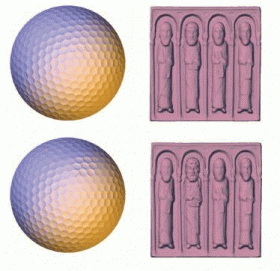July 10, 2008 feature
3D Graphics Can Geometrically Guide Your Attention

(PhysOrg.com) -- When you gaze at a painting, the first thing that catches your eye is usually not an accident. Since the beginning of art, painters have used strategic techniques to guide a viewer’s attention through a scene. Still to this day, researchers are investigating ways to persuade attention with the latest technology.
Most recently, computer scientists from the University of Maryland have shown that altering the geometry of 3D scenes can offer a new, unexplored technique for guiding a viewer’s attention through an interactive 3D medium. They’ve developed a method that sharpens or smoothes edges to make a particular region stand out. Their technique could be used by artists in designing 3D graphics, where visual persuasion could facilitate the understanding of complex images or provide users a more rewarding interactive experience.
“The most exciting feature of our work is that it shows that geometry alterations can be used to persuade visual attention in a meaningful way,” computer scientist Amitabh Varshney told PhysOrg.com. “Until now, the only channels of modification available to a visual attention persuader were the same ones that have been used for centuries – color, illumination, and detail contrasts. Our work shows that one can now add geometry to that mix.”
In their recent study published in IEEE Transaction on Visualization and Computer Graphics, Varshney and Youngmin Kim explain how geometric alteration can be achieved by a mesh filter. Basically, a graphic artist selects which region of a scene they want to catch the viewer’s attention, and highlight it using a circular or rectangular tool. Then, the mesh filter sharpens (emphasizes) the centermost points of the region, and smoothes (deemphasizes) the surrounding regions. The more pronounced the original topography of the region is, the greater the effect. If a surface is completely flat, there is no enhancement.
The result, according to eye-tracking tests, is a subtle persuasion toward the selected region of interest. In these tests, subjects (who didn’t know what the goal of the test was) spent significantly more time gazing at the geometrically altered regions in various 3D scenes, as compared with the original scenes or scenes modified by an alternative method (a Gaussian-based enhancement method). However, it’s still unclear exactly why people tend to look at these altered regions.
“One way to explain this could be that altering geometry indirectly induces a greater contrast in color, illumination, or detail,” Varshney said. “However, it may also be possible that the human visual system is processing the geometry alterations at a pre-attentive level. Although we do not have any evidence to support this, in a brilliantly designed study, Enns and Rensink have shown that 3D orientation of objects (and not just the 2D aspects of their image) is visually salient.”
One advantage of the new geometry-based alteration method is that it can be used in addition to other principles of visual persuasion, such as contrast in color, luminance, and texture. The geometric manipulation occurs before these techniques, giving artists flexibility in making adjustments later on.
The researchers plan to investigate exactly how the geometric technique interacts with the other conventional techniques – whether they reinforce each other, or perhaps cancel each other out. They will also experiment with the effect of “negative” geometry, where sharpening and smoothing are reversed, as well as developing persuasion filters that are guided by specific features in addition to regions.
“This could be useful for drawing visual attention in almost any 3D visual application that has geometric content – from scientific visualization of large-scale, time-varying phenomena to 3D games,” Varshney said.
More information: Kim, Youngmin; and Varshney, Amitabh. “Persuading Visual Attention through Geometry.” IEEE Transaction on Visualization and Computer Graphics, Vol. 14, No. 4, July/August 2008.
Copyright 2008 PhysOrg.com.
All rights reserved. This material may not be published, broadcast, rewritten or redistributed in whole or part without the express written permission of PhysOrg.com.





















